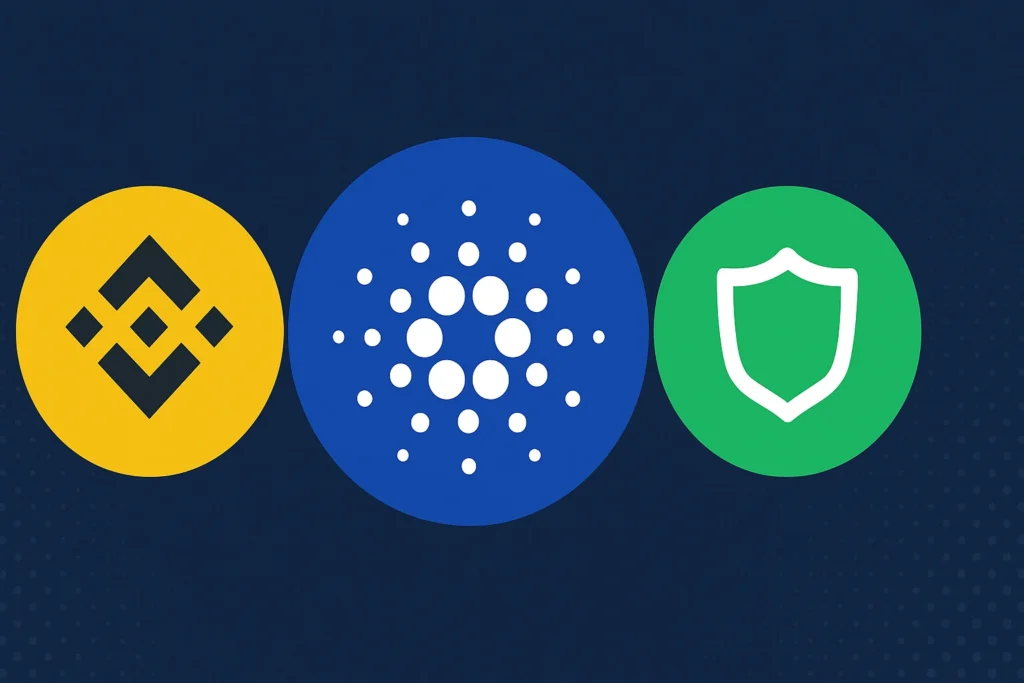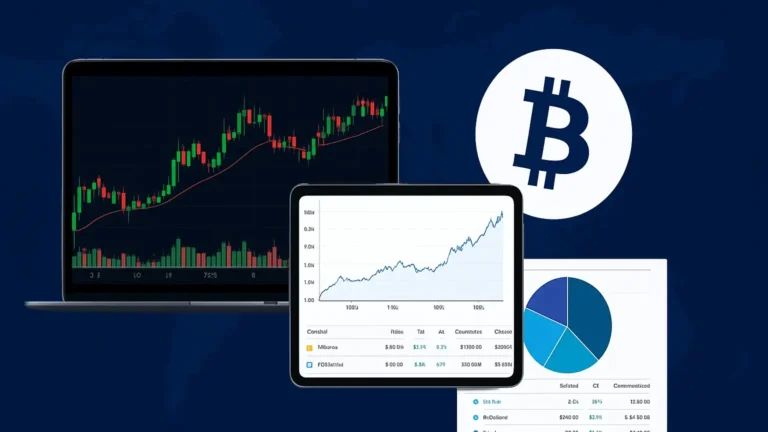How To Stake Cardano 3 Best Platforms
How to stake cardano on binance, coinbase and on trust wallet

Staking has become one of the most popular ways for crypto holders to earn passive income, and Cardano (ADA) offers one of the most stable and rewarding ecosystems to stake in.
Whether you’re new to crypto or a seasoned investor, understanding how to stake ADA on top platforms like Binance, Coinbase, and Trust Wallet can make a significant difference in your crypto journey. This guide will walk you through everything—step by step.
How to Stake Cardano on Binance

Step-by-Step Guide to Staking ADA on Binance
Staking ADA on Binance is straightforward and perfect for beginners who prefer a user-friendly interface. Here’s a step-by-step guide:
- Log into your Binance account. If you don’t have one, you’ll need to register and verify your identity.
- Deposit or buy ADA. Navigate to the “Buy Crypto” section or transfer ADA from another wallet.
- Go to the ‘Earn’ section. Hover over “Earn” in the top menu and click on “Simple Earn.”
- Search for ADA. Use the search bar to find ADA staking options.
- Choose between Flexible and Locked staking. Flexible allows withdrawal anytime; Locked offers higher returns.
- Enter the amount of ADA to stake. Choose how much you want to commit.
- Confirm and stake. Click “Confirm” and your ADA is now staked!
Binance’s platform handles all the technical parts for you, so even if you’re not tech-savvy, it’s still super easy to get started.
Read: How to stake solana for reward
Binance Flexible vs. Locked Staking Explained
Binance offers two types of staking for ADA:
- Flexible Staking: You can withdraw your funds anytime without penalties. Great for beginners who may need access to their ADA quickly.
- Locked Staking: You commit your ADA for a fixed period (e.g., 30, 60, or 90 days) in exchange for higher APY. The downside is that you can’t touch your funds during the lockup.
Flexible is ideal if you want liquidity, while Locked is better if you’re holding long-term and want to maximize returns.
Pros and Cons of Staking on Binance
Pros:
- Beginner-friendly interface
- No need to manage private keys
- Offers competitive APY
- Integrated with other Binance services
Cons:
- Custodial staking (you don’t control your private keys)
- Subject to Binance’s terms and operational risks
- Locking periods may restrict access to funds
How to Stake Cardano on Coinbase

ADA Staking Availability on Coinbase
Coinbase, one of the most trusted cryptocurrency exchanges in the United States and globally, has made it simple for users to stake ADA directly from their platform.
But not all users can access this feature. ADA staking on Coinbase is available only in certain jurisdictions due to regulatory constraints.
If you’re located in the U.S. (except in some restricted states) or supported international regions, you can likely participate in ADA staking on Coinbase.
Coinbase allows users to stake ADA directly from their account balances, so there’s no need to transfer funds or use third-party platforms. This streamlined experience is particularly appealing to users who want a hassle-free way to earn staking rewards with minimal technical knowledge.
However, it’s important to note that Coinbase operates on a custodial staking model. This means you do not control your private keys—Coinbase holds your assets and handles the delegation process on your behalf. While convenient, this also means you are placing your trust in Coinbase’s security protocols.
Step-by-Step Process to Stake on Coinbase
Staking ADA on Coinbase is as easy as flipping a switch. If you have an existing Coinbase account, follow these simple steps:
- Log into your Coinbase account.
- Buy or deposit ADA. Use the “Buy” button or transfer ADA from an external wallet.
- Check staking eligibility. Navigate to your ADA holdings and see if a “Stake” button appears.
- Opt-in to staking. Click on the “Stake” or “Start Earning” button. Review the terms and conditions, and confirm.
- Begin earning rewards. Once activated, your ADA will automatically begin earning staking rewards.
Coinbase takes care of validator selection, delegation, and other backend operations. You can monitor your staking rewards directly in your dashboard under the “Earn” section.
Coinbase Staking Rewards and Fees
Coinbase offers around 2% to 3.5% APY for ADA staking, although this rate may vary depending on network conditions and Coinbase’s internal fee structure.
The platform takes a commission from your staking rewards—usually around 25%—for providing staking services. So, if the protocol rewards 4%, you might end up receiving 3% after Coinbase’s cut.
While this might seem high compared to staking directly through a wallet or lower-fee validator, the trade-off is convenience, security, and ease of use. Coinbase users are often willing to accept slightly lower returns in exchange for a more seamless staking experience.
How to Stake Cardano on Trust Wallet

Setting Up Trust Wallet for Staking
Trust Wallet is one of the most popular mobile wallets in the crypto space, offering non-custodial control over your assets, including ADA. If you’re someone who prefers to hold their own keys and interact directly with the blockchain, Trust Wallet is a great option for ADA staking.
Before you can stake ADA on Trust Wallet, you’ll need to:
- Download Trust Wallet from the App Store or Google Play Store.
- Create a new wallet or import an existing one using your recovery phrase.
- Backup your recovery phrase. Store it safely—it’s the only way to recover your funds.
- Enable the Cardano network. Tap the settings icon, go to “Manage Tokens,” and search for ADA to enable it.
- Deposit ADA. Transfer ADA to your Trust Wallet address from an exchange or another wallet.
Once your ADA shows up in Trust Wallet, you’re ready to delegate it and start staking.
Choosing a Validator and Delegating ADA
Unlike centralized exchanges, Trust Wallet allows you to manually choose the validator (stake pool) to delegate your ADA to. This means you have greater control over the staking process and can potentially earn higher rewards by choosing a high-performing validator with low fees.
Here’s how to stake:
- Go to your ADA wallet inside Trust Wallet.
- Tap on “More” and then “Stake.”
- Select a validator from the list. You’ll see information about each pool’s performance, fees, and rewards.
- Enter the amount of ADA you want to stake.
- Confirm the transaction and approve with your password or biometric ID.
Once submitted, your ADA will be delegated, and rewards will start accruing after a few epochs (typically 15-20 days). You can unstake anytime, but there may be a cooldown period depending on the protocol rules.
Risks and Rewards of Trust Wallet Staking
Pros:
- Full control of your private keys
- Transparent validator selection
- Higher potential APY (3.5% to 6%)
- Easy mobile access
Cons:
- Slightly more complex than exchange staking
- Responsibility for managing your keys and wallet security
- Delays in reward activation (Cardano has a 15-20 day epoch delay for new delegations)
Trust Wallet is ideal for users who prioritize decentralization, security, and flexibility. However, it’s crucial to stay vigilant—losing your private keys or sending funds to the wrong address can result in permanent loss.
Comparison of Binance, Coinbase, and Trust Wallet for ADA Staking
User-Friendliness
- Binance: High; suitable for beginners. Simple Earn interface makes it easy.
- Coinbase: Very high; one-click staking with zero technical involvement.
- Trust Wallet: Moderate; requires understanding wallets and delegation.
For absolute beginners, Coinbase offers the easiest path. Binance comes next with slightly more options, while Trust Wallet is best for users comfortable with crypto wallets.
Reward Rates
- Binance: 3% to 5%, depending on staking type (Flexible vs Locked)
- Coinbase: 2% to 3.5%, after Coinbase’s commission
- Trust Wallet: 4% to 6%, depending on validator performance and fees
If maximizing returns is your priority, Trust Wallet generally offers the highest potential APY, provided you choose the right validator.
Security and Control
- Binance & Coinbase: Custodial; you don’t control private keys.
- Trust Wallet: Non-custodial; you own and manage your keys.
Trust Wallet wins in terms of decentralization and security since you have full control over your assets. However, this also means greater responsibility.
Things to Consider Before Staking Cardano
Lockup Periods and Accessibility
One of the most crucial factors to consider before staking ADA is the lockup period. While Cardano itself doesn’t have a hard lockup on staking (your funds are technically always accessible), the platform or wallet you use might enforce one. For instance, Binance’s locked staking options often require you to commit your ADA for a certain duration—30, 60, or 90 days—without the ability to withdraw it early.
Coinbase, on the other hand, allows users to withdraw ADA, but rewards might stop accruing if you un-stake early or transfer the coins. Trust Wallet, being non-custodial, technically allows access to your ADA at any time, but because of Cardano’s epoch-based system, it might take a few days for rewards to kick in or stop once you un-delegate.
So, before staking:
- Check platform-specific lockup policies.
- Evaluate how often you need access to your funds.
- Decide whether maximizing APY or maintaining liquidity is more important.
By carefully weighing these factors, you can ensure your staking strategy aligns with your financial goals and risk tolerance.
Custodial vs. Non-Custodial Staking
This is a biggie—do you want full control over your crypto, or are you comfortable letting an exchange manage it for you?
- Custodial Staking (e.g., Binance, Coinbase): The exchange controls your private keys. This is simpler and safer for beginners but carries platform risk (e.g., if the exchange gets hacked or shuts down).
- Non-Custodial Staking (e.g., Trust Wallet): You hold your private keys and directly interact with the Cardano network. This provides full control but also requires a higher degree of responsibility and security awareness.
Here’s a quick table to help you visualize the difference:
| Feature | Custodial (Binance/Coinbase) | Non-Custodial (Trust Wallet) |
|---|---|---|
| Control of Private Keys | No | Yes |
| Ease of Use | High | Medium |
| Responsibility | Low | High |
| APY Potential | Moderate | High |
| Security Risk | Exchange-based | User-based |
In short, if you’re new to crypto and prefer simplicity, custodial might be right for you. But if you value decentralization and full ownership, non-custodial is the way to go.
Tax Implications of Staking ADA
Let’s not forget the taxman. Staking ADA may be fun and profitable, but in most countries, the rewards you earn are considered taxable income. The exact regulations vary by jurisdiction, but here are some common tax scenarios:
- Reward Income: The ADA you earn from staking is typically considered income at the time it’s received, valued at the market price on that day.
- Capital Gains: If you later sell your staked ADA for a profit, you may also owe capital gains tax.
- Reporting: You’ll likely need to report staking rewards, even if you reinvest or never withdraw them.
Pro tip: Use crypto tax software like Koinly, TokenTax, or CoinTracker to automatically track your staking income and simplify reporting. And when in doubt, consult a tax professional familiar with crypto laws in your region.
How to Maximize Your Staking Rewards
Re-Staking and Compounding
One of the easiest ways to increase your staking returns over time is through compounding. Simply put, you take the rewards you’ve earned and add them back to your staking balance. Over time, this can significantly boost your earnings thanks to the magic of compound interest.
Some platforms like Binance and Coinbase may automatically re-stake your rewards, but Trust Wallet users will need to manually re-delegate earned ADA. Regardless of the method, make sure you’re:
- Monitoring your reward frequency
- Manually or automatically re-staking regularly
- Avoiding unnecessary transfer or transaction fees
This approach is especially powerful for long-term holders who want to turn their ADA into a steady income stream.
Staking Pools vs. Exchanges
Staking on an exchange might be easy, but it’s not always the most profitable option. Staking pools, particularly on non-custodial platforms like Trust Wallet or Daedalus/Yoroi, often offer:
- Higher APYs
- Greater transparency
- More decentralization
When selecting a staking pool:
- Look for low commission rates (under 5%)
- Check pool saturation (avoid over-saturated pools)
- Review historical performance and block production consistency
Some top-performing pools even share community updates, have zero fees for early delegators, or run educational campaigns. The extra 1–2% APY you can earn over time really adds up.
Avoiding High-Fee Validators
Fees can eat into your rewards—fast. Whether you’re staking through an exchange or a staking pool, always review the fee structure. Here’s a general rule of thumb:
- Exchanges: Usually take 10–25% of your rewards
- Low-fee Validators: Around 0–5% commission
- High-fee Validators: 6% and up (often unjustified unless they provide unique value)
If you’re staking through Trust Wallet, you’ll see validator fees before you delegate. Don’t rush—take a few minutes to compare validators using tools like pooltool.io or adapools.org.
Being fee-aware ensures more of your ADA stays in your pocket instead of someone else’s.
Is Staking Cardano Safe?
Security Risks
Cardano staking is generally considered safe, especially because it’s non-destructive—you’re not sending your coins away or locking them permanently. However, safety still depends on where and how you stake.
Potential risks include:
- Exchange hacks: If you’re staking on Binance or Coinbase, your funds are only as safe as their systems.
- User error: Sending ADA to the wrong address or mismanaging private keys can lead to permanent loss.
- Phishing and scams: Fake wallets and validator scams are rampant, especially for mobile wallet users.
Always use official apps and trusted validators, and enable two-factor authentication on all accounts.
Scams and Fake Validators
Scammers are creative. They create lookalike websites or offer “too good to be true” APYs to lure unsuspecting users. On Trust Wallet or other non-custodial platforms, users must choose validators carefully.
Avoid:
- Validators with zero track record
- Unknown pools promising 10%+ APY
- Staking services that require you to send ADA to a random address
Always verify validator information from official Cardano sources or reputable explorer tools.
Best Practices to Stay Safe
To keep your ADA and staking rewards safe, follow these guidelines:
- Use hardware wallets for extra security
- Backup your recovery phrases and store them offline
- Never share your private keys
- Use trusted apps and wallets
- Be skeptical of unsolicited offers and DMs
In the crypto world, your security is your responsibility. Staying informed and cautious is the best way to avoid trouble.
Benefits of Staking Cardano
Earn Passive Income
One of the biggest incentives for staking Cardano is passive income. By staking your ADA, you can earn around 3% to 6% annual percentage yield (APY), depending on where and how you stake. While this might not seem huge at first glance, compound those returns over time and it adds up—especially if ADA appreciates in value.
Imagine having $10,000 worth of ADA sitting in your wallet. If you stake it and earn 5% annually, that’s $500 just for holding onto your coins. No trading, no stress, just simple, steady earnings.
Support Network Security and Decentralization
When you stake your ADA, you’re not just making money—you’re contributing to the stability and decentralization of the Cardano network. More stakers mean a broader distribution of power among validators, reducing the risk of centralization and boosting overall network health.
This is crucial for the long-term success of any blockchain. The more decentralized a network is, the harder it becomes to hack or manipulate. So, by staking ADA, you’re doing your part to keep the ecosystem honest and secure.
Lower Barrier to Entry Compared to Mining
Unlike Bitcoin mining, which requires expensive ASIC miners, high electricity bills, and technical know-how, staking ADA is simple and accessible. All you need is a small amount of ADA, a wallet or exchange account, and a few minutes of your time.
Even if you only have a few ADA tokens, you can still participate in staking. Many staking pools have no minimum requirements, making it easy for anyone—from casual holders to serious investors—to earn rewards.
Conclusion
Staking Cardano (ADA) is one of the smartest and easiest ways to earn passive income in the crypto world. Whether you go with Binance for ease of use, Coinbase for beginner-friendly access, or Trust Wallet for full control and decentralization, the process is straightforward and secure if done right.
Each platform has its trade-offs:
- Binance offers flexible options and strong APYs, but you give up control.
- Coinbase is the most intuitive but charges high commission fees.
- Trust Wallet gives you full ownership, higher rewards, and flexibility, though it requires more attention to detail.
No matter which method you choose, staking ADA helps you earn while supporting one of the most promising blockchain networks out there. Just remember to be smart—do your research, stay safe, and always double-check where your ADA is going.
Happy staking! I hope you must understand about how to stake cardano.
FAQs
How often are Cardano staking rewards paid out?
Cardano staking rewards are typically paid out every 5 days, after the initial waiting period of 15 to 20 days (also called the warm-up period). Once that’s over, you’ll start receiving rewards at the end of each epoch.
Can I unstake ADA anytime?
Yes, especially if you’re staking through non-custodial wallets like Trust Wallet. Your ADA isn’t locked; however, if you’re using locked staking on Binance or another exchange, there may be specific lock periods where funds can’t be withdrawn until the end of the term.
Is staking Cardano better than staking Ethereum?
That depends on your goals. Cardano staking is simpler, energy-efficient, and often more accessible with lower fees. Ethereum staking requires 32 ETH for solo staking and has higher complexity. Cardano also has no lock-up period in non-custodial setups, giving it a clear advantage for flexibility.
Do I need to keep my ADA in the same wallet to receive rewards?
Yes. Once you delegate ADA to a validator, the rewards are sent to that same wallet. If you move your ADA, you’ll stop earning rewards. Always delegate from the wallet where you plan to keep your ADA for the long term.
What happens if a validator goes offline?
If a validator goes offline, your rewards may decrease or pause temporarily, but you won’t lose your ADA. It’s always safe to re-delegate to another active, reputable validator if the one you’re using underperforms or stops producing blocks.
Contents
- 1 How to stake cardano on binance, coinbase and on trust wallet
- 2 How to Stake Cardano on Binance
- 3 How to Stake Cardano on Coinbase
- 4 How to Stake Cardano on Trust Wallet
- 5 Comparison of Binance, Coinbase, and Trust Wallet for ADA Staking
- 6 Things to Consider Before Staking Cardano
- 7 How to Maximize Your Staking Rewards
- 8 Is Staking Cardano Safe?
- 9 Benefits of Staking Cardano
- 10 Conclusion
- 11 FAQs






Thanks for valuable info.